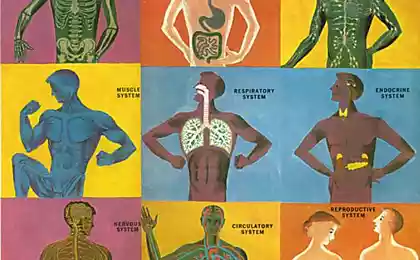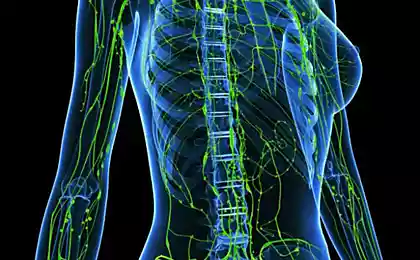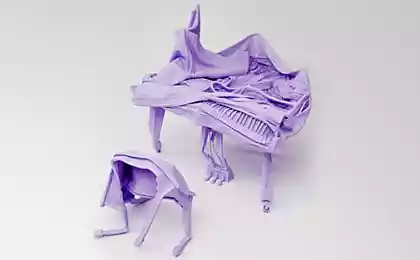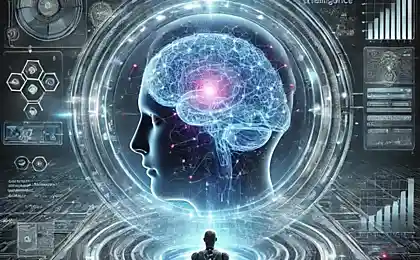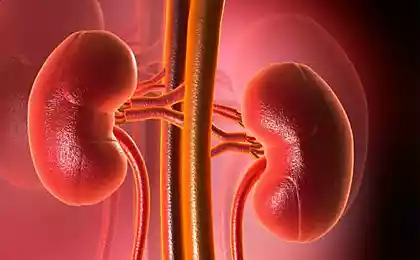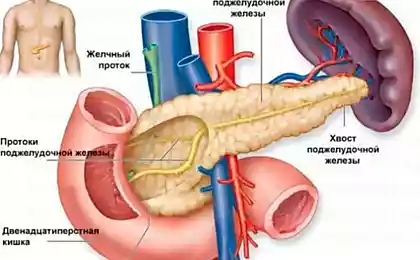980
Digestive system: how it works
The vital functions of the human body is impossible without a constant exchange of substances with the external environment. Food contains vital nutrients used by the body as a plastic material (to build cells and tissues of the body) and energy (as a source of energy, necessary for vital activity of organism).
Water, mineral salts, vitamins absorbed by the body in the form in which they are in food. Natural compounds: proteins, fats, carbohydrates can not be absorbed in the digestive tract without splitting to simpler compounds.
The digestive system provides reception of food, its mechanical and chemical processing, the promotion of “food mass through the digestive canal, the absorption of nutrients and water in the blood and lymph stream and removal from the body undigested food residues in the form of feces.

Digestion is a set of processes that ensures mechanical grinding of food and chemical breakdown of macromolecules nutrients (polymers) into components suitable for suction (monomers).
The digestive system includes the gastrointestinal tract, as well as the bodies exercising Sirkeci digestive juices (salivary glands, liver, pancreas). The gastrointestinal tract starts with the mouth, includes the mouth, esophagus, stomach, small intestine and large intestine which ends at the anus.
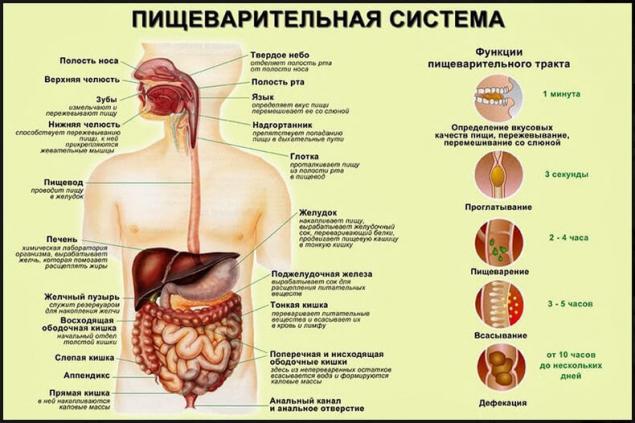
The main role in the chemical processing of foods belongs to ferments (enzymes), which, despite great diversity, share some common properties. For enzymes is characterized by:
High specificity – each one catalyzes only one reaction or only works on one type of communication. For example, protease or proteolytic enzymes break down proteins to amino acids (pepsin stomach trypsin, chymotrypsin, duodenal ulcer, etc.); lipases, or lipolytic enzymes to break down fats to glycerol and fatty acids (lipase small intestine, etc.); amylase, or glycolytic enzymes that break down carbohydrates into monosaccharides (maltase in the saliva, amylase, lactase and maltase of the pancreatic juice).
Digestive enzymes are only active at a certain pH value environment. For example, the stomach pepsin acts only in an acidic environment.
Operate in a narrow range of temperatures (from 36 °C to 37 °C), outside this temperature interval, their activity decreases, which is accompanied by violation of processes of digestion.
Possess high activity, so break down large amounts of organic substances.
The main functions of the digestive system:1. Secretion – the formation and secretion of digestive juices (gastric, intestinal), which contain enzymes and other biologically active substances.
2. Motor-evacuation, or motor, provides a reduction and promotion of food masses.
3. Absorptive transfer of all end-products of digestion, water, salts and vitamins through the mucous membrane of the alimentary canal into the blood.
4. Excretory (urinary) – the body's excretion of metabolic products.
5. Endocrine – the secretion of the digestive system special hormones.
6. Protective:
DIGESTION IN THE ORAL CAVITY. THE FUNCTION OF SALIVARY GLANDS
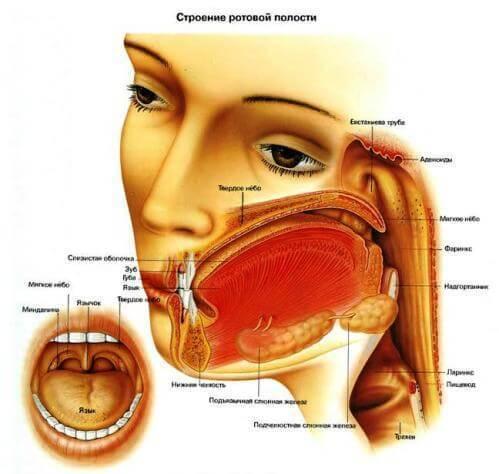
Mouth performed the analysis of the flavours of your food, protecting the digestive tract from low-quality of nutrients and exogenous microorganisms (saliva contains lysozyme, which has bactericidal action and endonuclease providing antiviral activity), milling, wetting the food with saliva, starting the hydrolysis of carbohydrates, formation of food bolus, stimulation of the receptor with the subsequent initiation of activities not only of the glands of the mouth but the digestive glands of the stomach, pancreas, liver, duodenum.
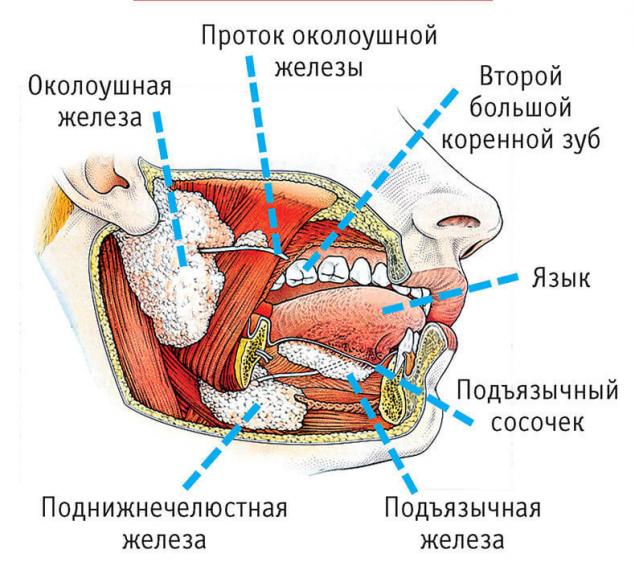
The salivary glands. Human saliva is produced by 3 pairs bolisani glands: parotid, sublingual, submandibular, and many minor glands (Hey, buccal, lingual, etc.) scattered in the mucosa of the mouth. Daily is formed of 0.5 – 2 liters of saliva, the pH of which is 5.25 and 7.4.
Important components of saliva are proteins that possess bactericidal properties (lysozyme, which destroys cell wall of bacteria as well as immunoglobulins and lactoferrin that binds iron ions and preventing their capture by the bacteria), and enzymes: a-amylase, and maltase, which begin the breakdown of carbohydrates.
The saliva starts to be allocated in response to the stimulation of the receptors of the oral cavity food is an unconditional stimulus, and at the sight, smell of food and the environment (conditioned stimuli). Signals from the taste, thermo - and mechanoreceptors of the oral cavity are transmitted to the center of salivation medulla oblongata, where the switching signals on the secretory neurons, the totality of which is located in the nucleus of the facial and glossopharyngeal nerves.
The result is clonerefdata response of salivation. In the regulation of salivation are involved parasympathetic and sympathetic nerves. When activated, the parasympathetic nerve of the salivary gland, a large volume of liquid saliva in the activation of the sympathetic – the volume of saliva is less, but it has more enzymes.
Chewing is to grind food, wetting it with saliva and forming the bolus. In the process of mastication would be used to evaluate the taste of food. Next, pmodulename food enters the stomach. For the implementation of the chewing and swallowing requires coordinated work of many muscles shrink which regulates and co-ordinate the centres for chewing and swallowing located in the CNS.
During swallowing the entrance to the nasal cavity is closed, but open top and bottom esophageal sphincter and food enters the stomach. Dense food passes through the esophagus for 3 to 9 seconds, the liquid for 1 – 2 seconds.
DIGESTION IN THE STOMACH
In the stomach, food stays for 4-6 hours for chemical and mechanical processing. In the stomach there are 4 parts: the entrance, or cardiac part, top – bottom (or set), the average largest part of the body of the stomach and lower – antral part of ending the pyloric sphincter, or pylorus (the orifice of the pylorus leads to the duodenum).
The stomach wall consists of three layers: the external serous, middle muscular and inner mucous. Muscle contraction of the stomach causes both wave-like (peristaltic) and pendulum movement, which food is mixed and moved from the entrance to the exit of the stomach.
In the gastric mucosa are numerous glands that produce gastric juice. Poluperiferiinye from the stomach chyme (chyme) enters the intestines. On the transition of the stomach into the intestine is the pyloric sphincter, which, when reduced completely separates the stomach from the duodenum.
The mucous membrane of the stomach forms longitudinal, oblique and transverse folds are straightened when filling of the stomach. Beyond the phase of digestion the stomach is in the sleeping state. In 45 – 90 minute rest period occur, cuts the stomach, lasting 20 – 50 minutes (hungry peristalsis). The capacity of the stomach of an adult is from 1.5 to 4 L.
Functions of the stomach:
The composition and properties of gastric juiceGastric juice is produced by gastric glands, which are located in the bottom (the body) and the body of the stomach. They contain 3 types of cells:
At rest ("fasting") from the human stomach can extract approximately 20 to 50 ml gastric juice, pH 5.0. The total amount of gastric juice that is released when a normal diet, equivalent to 1.5 – 2.5 liters per day. the active pH of gastric juice is between 0.8 and 1.5, because in it contains about 0.5% HCl.
The Role Of HCl. Increases excretion of pepsinogen primary cells, contributes to the translation of pepsinogen in pepsin, creates an optimum environment (pH) for the activities of proteases (pepinov), causes swelling and denaturation of proteins of food that provides increased protein breakdown and also promotes the destruction of microbes.
Factor Castle. Food contains vitamin B12, essential for red blood cell formation, the so-called external factor castle. But be absorbed into the bloodstream it can only in the presence of the gastric intrinsic factor. This gastronomiepreis, which includes a peptide otdalyayutsya from pepsinogen when it is turning into pepsin, and mucoid, eye-catching plus cells of the stomach. When secretory activity of the stomach is reduced, the production of castle's factor is also reduced, and accordingly decreases the absorption of vitamin B12, resulting in gastritis with reduced secretion of gastric juice, usually accompanied by anemia.
Phase of gastric secretion:1. Clonerefdata, or brain, lasts for 1.5 – 2 h, where the secretion of gastric juice occurs under the influence of all the factors that accompany the meal. This conditional reflexes arising at sight, smell of food, the atmosphere, combined with the absolute that occurs when chewing and swallowing. The juice emitted is influenced by the sight and smell of food, chewing and swallowing, is called "light" or "glow." It prepares the stomach to receive food.
2. Gastric, or neurohumoral, phase, in which stimuli of secretion occur in the stomach: the secretion is enhanced by the stretching of the stomach (mechanical stimulation) and the effects on his mucous extractives food and products of hydrolysis of proteins (chemical stimulation). The main hormone in the activation of gastric secretion in the second phase is gastrin. Development of gastrin and histamine also occurs under the influence of local reflexes metasomaticheskie nervous system.
Humoral regulation is attached via 40 – 50 minutes after the beginning of the brainstorming phase. In addition to the activating effects of hormones gastrin and histamine, activating the production of gastric juice occurs under the influence of chemical components of extractive substances of the food, primarily meat, fish, vegetables. When cooking foods they move to the herbal teas, broths, quickly absorbed into the bloodstream and activate the digestive system.
Such substances primarily include free amino acids, vitamins, biostimulants, set of mineral and organic salts. Fat initially inhibits the secretion and slow down the evacuation of chyme from the stomach into the duodenum, but then it stimulates the digestive glands. Therefore, with increased gastric secretion is not recommended herbal teas, broths, cabbage juice.
Most strongly the gastric secretion is increased under the influence of protein and can last up to 6-8 hours, the weakest it changes under the influence of bread (no more than 1 hour). With prolonged human presence on carbohydrate diet the acidity and digestive power of gastric juice is reduced.
3. Intestinal phase. In the intestinal phase is the inhibition of secretion of gastric juice. It develops during the transition of chyme from the stomach into the duodenum. In contact with acidic food bolus in the duodenum begin to be produced hormones, dampening the secretion of gastric, secretin, cholecystokinin, and others. The amount of gastric juice is reduced by 90 %.
DIGESTION IN THE SMALL INTESTINE
Small intestine – the longest part of the digestive tract length of 2.5 – 5 meters. The small intestine is divided into three sections: duodenum, jejunum and ileum. In the small intestine is the absorption of the products of splitting of nutrients. The mucous membrane of the small intestine forms circular folds, the surface of which is covered with numerous outgrowths of the intestinal villi length 0.2 – 1.2 mm, which increases the surface of the colon.
Within each villus is composed of arteriole and a lymphatic capillary (lacteal sine), and go venules. In the villus arterioles divide into capillaries, which merge to form venules. Arterioles, capillaries and venules in the villi are arranged around the milky sinus. Intestinal glands are located deep in the mucosa and produce intestinal juice. In the mucosa of the small intestine laid numerous single and group of lymphatic nodules that performs a protective function.
Intestinal phase – the active phase of digestion of nutrients. In the small intestine is mixed acidic contents of the stomach with alkaline secrets of the pancreas, intestinal glands and liver and the breakdown of nutrients to end-products absorbed into the blood, as well as the promotion of food mass towards to the large intestine and excretion of metabolites.
Throughout the digestive tube is lined with mucous membranethat contains glandular cells that secrete different components of the digestive juice. The digestive juices consist of water, inorganic and organic substances. Organic matter is mainly proteins (enzymes) hydrolases that contribute to the splitting of large molecules into small: glycolytic enzymes break down carbohydrates into monosaccharides, protein – oligopeptides to amino acids, lipolytic fats to glycerol and fatty acids.
The activity of these enzymes is highly dependent on temperature and pH, and the presence or absence of their inhibitors (for example, they do not digest the stomach wall). The secretory activity of digestive glands, the composition and properties of the allocated secret depend on diet and nutrition.
In the small intestine occur cavitary digestion, and digestion in the area of the brush border of the enterocytes (mucosal cells) of the intestine – digestion (A. M. Ugolev, 1964). Wall, or contact, digestion only occurs in the small intestine at the contact of chyme with their wall. The enterocytes supplied with mucus-covered hairs, the space between which is filled with a dense substance (glycocalyx), which contains strands of glycoproteins.
They, along with mucus is able to adsorb digestive enzymes of the pancreatic juice and the intestinal glands, with their concentration reaches high values, and the decomposition of complex organic molecules to simple is more efficient.
The amount of digestive juices produced by all of the digestive glands is 6-8 liters per day. Most of them in the intestine is absorbed back. Absorption is a physiological process of transport of substances from the lumen of the alimentary canal into blood and lymph. The total amount of fluid intake daily in the digestive system, is 8 – 9 l (примерно1 5 liters of food, the remainder is a liquid secreted by glands of the digestive system).
Mouth absorbed a bit of water, glucose and certain drugs. In the stomach, absorbed water, alcohol, a little salts and monosaccharides. The main Department of the gastrointestinal tract, where the absorbed salts, vitamins and nutrients is the small intestine. High rate of absorption provided by the presence of folds along its entire length, with the result that the surface suction increases three times, and the presence of villi on the epithelial cells through which the surface suction increases to 600 times. Inside each villus is a dense network of capillaries, and their walls have large pores (45 – 65 nm) that can penetrate even quite large molecules.
Contractions of the wall of the small intestine ensure the promotion of chyme in the distal direction, mixing it with digestive juices. These reductions occur as a result of coordinated contractions of smooth muscle cells of the outer longitudinal and inner circular layers. Types of motility of the small intestine: rhythmic segmentation, pendulum movement, tonic and peristaltic contractions.
Regulation of of cuts is carried out mainly by local reflex mechanisms involving the nerve plexus of the bowel wall, but under the control of the Central nervous system (for example, when strong negative emotions may be a sharp activation of motility intestine, which will lead to the development of "nervous diarrhea"). When the excitation of the parasympathetic fibers of the vagus nerve bowel motility is enhanced at excitation of sympathetic nerves is inhibited.
THE ROLE OF LIVER AND PANCREAS IN DIGESTION
The liver is involved in digestion, secreting bile. The bile produced by the liver cells continuously, and enters the duodenum via common bile duct only in the presence of her food. When digestion stops, the bile accumulates in the gallbladder, where as a result of water absorption, the concentration of bile increases in 7 – 8 times.
The bile released in the duodenum, does not contain enzymes and is only involved in emulsification of fats (for more successful action of lipase). In the day its produced of 0.5 – 1 l In the bile contains bile acids, bile pigments, cholesterol, a variety of enzymes. Bile pigments (bilirubin, biliverdin), which are the breakdown products of hemoglobin, it gives the bile a Golden yellow color. The bile secreted into the duodenum in 3 – 12 minutes after the start of the meal.
Functions of bile:
Increase the secretion of bile yolks, milk, meat, bread. Cholecystokinin stimulates gallbladder contraction and bile flow into the duodenum.
The liver is constantly synthesized and consumed glycogen – a polysaccharide that is a polymer of glucose. Epinephrine and glucagon increase glycogen breakdown and entry of glucose from the liver into the blood. In addition, the liver performs neutralization of harmful substances entering the body from outside or formed during the digestion of food, due to the activity of a powerful enzyme systems for hydroxylation and neutralization of foreign and toxic substances.

Pancreas refers to the glands of mixed secretion, is composed of endocrine and exocrine departments. Endocrine division (cells of the islets of Langerhans) secretes hormones directly into the bloodstream. In the Department of exocrine (80% of the total pancreas) produces pancreatic juice which contains digestive enzymes, water, bicarbonate, electrolytes, and special excretory ducts enters the duodenum simultaneously with the bile, as they have common sphincter with the duct of the gallbladder.
Per day produced a 1.5 – 2.0 l of pancreatic juice, pH 7,5 – 8,8 (due to HCO3 -) to neutralize the acidic content of the stomach and create an alkaline pH at which work better pancreatic enzymes hydrolyzing all types of nutrients (proteins, fats, carbohydrates, nucleic acids).
Proteases (trypsinogen, chymotrypsinogen, etc.) are produced in an inactive form. To prevent autodigestion the same cells that secrete trypsinogen, at the same time produce trypsin inhibitor, therefore, most pancreas trypsin and other enzymes break down proteins inactive. Activation of trypsinogen occurs only in the cavity of the duodenum, and active trypsin, in addition to the hydrolysis of proteins causes activation of other enzymes in the pancreatic juice. The pancreatic juice also contains enzymes that break down carbohydrates (α-amylase) and fats (lipase).
DIGESTION IN THE LARGE INTESTINE
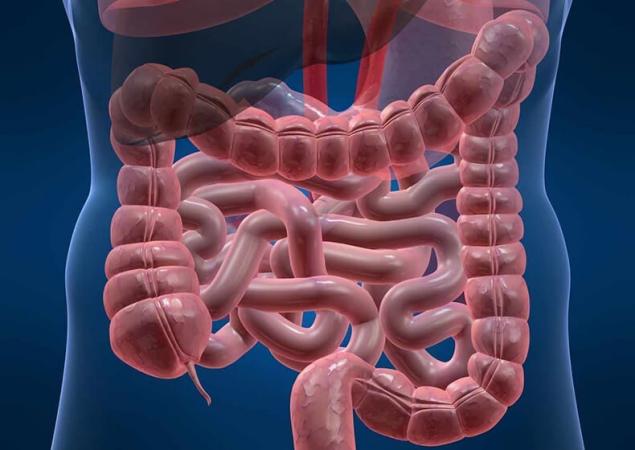
The intestines
The large intestine consists of the blind, colon and rectum. From the lower wall of the cecum departs vermiform Appendix (Appendix), in the walls which is a lot of lymphoid cells, so it plays an important role in immune reactions.
In the colon there is a final absorption of essential nutrients, excretion of metabolites, and salts of heavy metals, the accumulation of dehydrated intestinal contents and remove it from the body. A day in an adult is formed and displayed 150-250 g of feces. In the large intestine is the absorption of the main volume of water (5 – 7 l per day).
Reduction of the large intestine occur mainly in the form of a slow pendulum and peristaltic movements, which ensures maximum absorption of water and other components in the blood. Motility (peristalsis) of the colon is enhanced during food, passage of food through the esophagus, stomach, duodenum.
Braking power is carried out from the rectum, irritation of the receptors which reduces the motor activity of the colon. Meals rich in dietary fiber (cellulose, pectin, lignin) increases the amount of stool and accelerates its promotion of the intestines.
Microflora of the colon. The last parts of the colon contain a lot of microorganisms, primarily sticks of the genus Bifidus and Bacteroides. They are involved in the destruction of enzymes coming from the chyme from the small intestine, synthesis of vitamins, metabolism of proteins, phospholipids, fatty acids, cholesterol. The protective function of bacteria lies in the fact that the intestinal microflora in the host body acts as a constant incentive to develop natural immunity.
In addition, the normal gut bacteria act as antagonists against pathogenic microbes and inhibit their reproduction. The activity of the microflora of the gut may be broken after long-term administration of antibiotics, resulting in bacterial death, but begin to develop the yeast fungi. Intestinal microbes synthesize vitamins K, B12, E, B6, and other biologically active substances that support the processes of fermentation and reduce the processes of decay.
REGULATION OF THE ACTIVITIES OF THE DIGESTIVE SYSTEM
Regulation of the gastrointestinal tract is provided with Central and local nervous and hormonal influences. Central nervous effects of the most characteristic salivary glands, to a lesser extent for the stomach, local neural mechanisms play a significant role in the small and large intestines.
Central level regulation is carried out in the structures of the medulla oblongata and the brain stem, which together form the food center. Food centre coordinates the activities of the digestive system, i.e., regulate contractions of the walls of the gastrointestinal tract and secretion of digestive juices and regulates feeding behavior in General. Purposeful eating behavior is formed in part of the hypothalamus, limbic system and cerebral cortex.
Reflex mechanisms play an important role in the regulation of the digestive process. They studied the academician I. P. Pavlov, developing methods of chronic experiment, allowing to obtain the necessary for the analysis of pure juice at any time of the digestion process. He showed that the secretion of digestive juices in large measure due to the process of eating. Basal secretion of digestive juices very little. For example, on an empty stomach is approximately 20 ml of gastric juice and digestion – 1200 – 1500 ml.
Reflex regulation of digestion is performed by means of conditioned and unconditioned alimentary reflexes.
Conditioned food reflexes are produced in the course of individual life and appear to the sight, smell of food, time, sounds and atmosphere. Unconditional food reflexes originate from receptors of the oral cavity, pharynx, esophagus and the stomach when the flow of food and play a major role in the second phase of gastric secretion.
The conditioned reflex mechanism is the only one in the regulation of salivation and important for the initial secretion of the stomach and podjeludochnoi glands in their activities ("glow" juice). This mechanism is observed in the I phase of gastric secretion. The intensity of secretion during phase I depends on the appetite.
Nervous regulation of gastric secretion is autonomic nervous system through parasympathetic (vagus nerve) and sympathetic nerves. Using neurons of the vagus nerve is activated gastric secretion, and the sympathetic nerves exert a braking effect.
Local mechanism for the regulation of digestion is carried out using peripheral ganglia located in the walls of the gastrointestinal tract. The local mechanism is important in the regulation of intestinal secretion. It activates the secretion of digestive juices only in response to the entry of chyme into the small intestine.
A huge role in the regulation of secretory processes in the digestive system of hormones that are produced by cells located in various departments most of the digestive system and act through the blood or through the extracellular fluid to neighboring cells. Through the blood are gastrin, secretin, cholecystokinin (pancreozymin), motilin etc. neighboring cells are somatostatin, VIP (vasoactive intestinal polypeptide), substance P, endorphins, etc.
The main site of secretion of hormones of the digestive system – the initial section of the small intestine. Altogether there are about 30. The release of these hormones occurs when the cells of the diffuse endocrine system of the chemical components of food masses in the lumen of the digestive tube, as well as the action of acetylcholine which is the neurotransmitter of the vagus nerve, and some regulatory peptides.
Major hormones of the digestive system:1. Gastrin is formed in the accessory cells of the pyloric part of the stomach and activates the chief cells of the stomach that produce pepsinogen, and parietal, producing hydrochloric acid, whereby it increases the secretion of pepsinogen and activates his transformation into the active form – pepsin. In addition, gastrin promotes the formation of histamine, which in turn also stimulates the production of hydrochloric acid.
2. Secretin is formed in the wall of the duodenum under the action of hydrochloric acid coming from the stomach with chyme. Secretin inhibits the secretion of gastric juice, activates the production of pancreatic juice (but not enzymes, but only a water and bicarbonate) and increases the effect of cholecystokinin on the pancreas.
3. Cholecystokinin, or pancreozymin, stands under the influence coming into the duodenum of the products of digestion. It increases the secretion of pancreatic enzymes and causes contraction of the gallbladder. And secretin, and cholecystokinin are able to inhibit secretion and motility of the stomach.
4. The endorphins. Inhibit the secretion of pancreatic enzymes, but increase the secretion of gastrin.
5. Motilin increases the motor activity of the gastrointestinal tract.
Some hormones can be released very quickly, helping to create a sense of saturation already at the table.
APPETITE. HUNGER. SATURATION

Hunger is a subjective sensation of food needs, which organizes human behavior and food intake. Hunger manifests itself in the form of a burning sensation and pain in the epigastric region, poteshnaya, weakness, dizziness, hungry peristalsis of the stomach and intestines. The emotional sensation of hunger is associated with activation of the limbic structures and cerebral cortex.
Central regulation of hunger is carried out through the activities of the food center, which consists of two main parts: a hunger center and satiety center located in the lateral (side) and Central nuclei of the hypothalamus respectively.
Activating the hunger center is due to the flow of impulses from chemoreceptors that respond to a lowering of blood levels of glucose, amino acids, fatty acids, triglycerides, the products of glycolysis or from mechanoreceptors of the stomach, excited when it is hungry peristalsis. Lowering the temperature of the blood may also contribute to the emergence of feelings of hunger.
Activation of the satiety center may occur before the hydrolysis products of the nutrients will come from the gastrointestinal tract into the blood, the basis on which to distinguish sensory saturation (primary) and exchange (secondary). Touch the saturation occurs due to irritation of receptors of the mouth and the stomach received food, and also as a result of conditioned-reflex reactions in response to sight, smell of food. Metabolic saturation occurs much later (after 1.5 – 2 hours after a meal), when the products of splitting of nutrients into the blood.
Anemia: causes and prevention
Metabolism nothing to do with it
Appetite is a feeling of need for food, emerging as a result of excitation of neurons of the cerebral cortex and the limbic system. Appetite contributes to the organization of the digestive system, improves digestion and nutrient absorption. Disorders of the appetite are manifested in the form of reduced appetite (anorexia) or increase (bulimia). Long deliberate restriction of food intake can lead not only to metabolic but also to pathological changes of appetite, up to total rejection of food. published
Source: butakova.info/blog/pishhevaritelnaya-sistema-stroenie-znachenie-funkcii.html
Water, mineral salts, vitamins absorbed by the body in the form in which they are in food. Natural compounds: proteins, fats, carbohydrates can not be absorbed in the digestive tract without splitting to simpler compounds.
The digestive system provides reception of food, its mechanical and chemical processing, the promotion of “food mass through the digestive canal, the absorption of nutrients and water in the blood and lymph stream and removal from the body undigested food residues in the form of feces.

Digestion is a set of processes that ensures mechanical grinding of food and chemical breakdown of macromolecules nutrients (polymers) into components suitable for suction (monomers).
The digestive system includes the gastrointestinal tract, as well as the bodies exercising Sirkeci digestive juices (salivary glands, liver, pancreas). The gastrointestinal tract starts with the mouth, includes the mouth, esophagus, stomach, small intestine and large intestine which ends at the anus.

The main role in the chemical processing of foods belongs to ferments (enzymes), which, despite great diversity, share some common properties. For enzymes is characterized by:
High specificity – each one catalyzes only one reaction or only works on one type of communication. For example, protease or proteolytic enzymes break down proteins to amino acids (pepsin stomach trypsin, chymotrypsin, duodenal ulcer, etc.); lipases, or lipolytic enzymes to break down fats to glycerol and fatty acids (lipase small intestine, etc.); amylase, or glycolytic enzymes that break down carbohydrates into monosaccharides (maltase in the saliva, amylase, lactase and maltase of the pancreatic juice).
Digestive enzymes are only active at a certain pH value environment. For example, the stomach pepsin acts only in an acidic environment.
Operate in a narrow range of temperatures (from 36 °C to 37 °C), outside this temperature interval, their activity decreases, which is accompanied by violation of processes of digestion.
Possess high activity, so break down large amounts of organic substances.
The main functions of the digestive system:1. Secretion – the formation and secretion of digestive juices (gastric, intestinal), which contain enzymes and other biologically active substances.
2. Motor-evacuation, or motor, provides a reduction and promotion of food masses.
3. Absorptive transfer of all end-products of digestion, water, salts and vitamins through the mucous membrane of the alimentary canal into the blood.
4. Excretory (urinary) – the body's excretion of metabolic products.
5. Endocrine – the secretion of the digestive system special hormones.
6. Protective:
- mechanical filter for large molecules-antigens, which is provided by the glycocalyx on the apical membrane of enterocytes;
- hydrolysis of antigens by enzymes of the digestive system;
- the immune system of the gastrointestinal tract presents special cells (Peyer's patches) in the small intestine and lymphoid tissue of the Appendix, which contains T - and b-lymphocytes.
DIGESTION IN THE ORAL CAVITY. THE FUNCTION OF SALIVARY GLANDS

Mouth performed the analysis of the flavours of your food, protecting the digestive tract from low-quality of nutrients and exogenous microorganisms (saliva contains lysozyme, which has bactericidal action and endonuclease providing antiviral activity), milling, wetting the food with saliva, starting the hydrolysis of carbohydrates, formation of food bolus, stimulation of the receptor with the subsequent initiation of activities not only of the glands of the mouth but the digestive glands of the stomach, pancreas, liver, duodenum.

The salivary glands. Human saliva is produced by 3 pairs bolisani glands: parotid, sublingual, submandibular, and many minor glands (Hey, buccal, lingual, etc.) scattered in the mucosa of the mouth. Daily is formed of 0.5 – 2 liters of saliva, the pH of which is 5.25 and 7.4.
Important components of saliva are proteins that possess bactericidal properties (lysozyme, which destroys cell wall of bacteria as well as immunoglobulins and lactoferrin that binds iron ions and preventing their capture by the bacteria), and enzymes: a-amylase, and maltase, which begin the breakdown of carbohydrates.
The saliva starts to be allocated in response to the stimulation of the receptors of the oral cavity food is an unconditional stimulus, and at the sight, smell of food and the environment (conditioned stimuli). Signals from the taste, thermo - and mechanoreceptors of the oral cavity are transmitted to the center of salivation medulla oblongata, where the switching signals on the secretory neurons, the totality of which is located in the nucleus of the facial and glossopharyngeal nerves.
The result is clonerefdata response of salivation. In the regulation of salivation are involved parasympathetic and sympathetic nerves. When activated, the parasympathetic nerve of the salivary gland, a large volume of liquid saliva in the activation of the sympathetic – the volume of saliva is less, but it has more enzymes.
Chewing is to grind food, wetting it with saliva and forming the bolus. In the process of mastication would be used to evaluate the taste of food. Next, pmodulename food enters the stomach. For the implementation of the chewing and swallowing requires coordinated work of many muscles shrink which regulates and co-ordinate the centres for chewing and swallowing located in the CNS.
During swallowing the entrance to the nasal cavity is closed, but open top and bottom esophageal sphincter and food enters the stomach. Dense food passes through the esophagus for 3 to 9 seconds, the liquid for 1 – 2 seconds.
DIGESTION IN THE STOMACH
In the stomach, food stays for 4-6 hours for chemical and mechanical processing. In the stomach there are 4 parts: the entrance, or cardiac part, top – bottom (or set), the average largest part of the body of the stomach and lower – antral part of ending the pyloric sphincter, or pylorus (the orifice of the pylorus leads to the duodenum).
The stomach wall consists of three layers: the external serous, middle muscular and inner mucous. Muscle contraction of the stomach causes both wave-like (peristaltic) and pendulum movement, which food is mixed and moved from the entrance to the exit of the stomach.
In the gastric mucosa are numerous glands that produce gastric juice. Poluperiferiinye from the stomach chyme (chyme) enters the intestines. On the transition of the stomach into the intestine is the pyloric sphincter, which, when reduced completely separates the stomach from the duodenum.
The mucous membrane of the stomach forms longitudinal, oblique and transverse folds are straightened when filling of the stomach. Beyond the phase of digestion the stomach is in the sleeping state. In 45 – 90 minute rest period occur, cuts the stomach, lasting 20 – 50 minutes (hungry peristalsis). The capacity of the stomach of an adult is from 1.5 to 4 L.
Functions of the stomach:
- depositing food;
- secretion – the secretion of gastric juice for digestion;
- movement – for movement and mixing of food;
- the absorption of certain substances into the blood (water, alcohol);
- excretory – excretion into the cavity of the stomach together with the gastric juice of some metabolites;
- endocrine – education of the hormones regulating activity of the digestive glands (eg, gastrin);
- protective bactericidal (in acid environment of the stomach kills most germs).
The composition and properties of gastric juiceGastric juice is produced by gastric glands, which are located in the bottom (the body) and the body of the stomach. They contain 3 types of cells:
- main, which produce a complex of proteolytic enzymes (pepsin And gastrici, pepsin);
- parietal, which produce hydrochloric acid;
- plus, which produces mucus (mucin, or mucoid). Thanks to this mucus, the stomach wall is protected from the action of pepsin.
At rest ("fasting") from the human stomach can extract approximately 20 to 50 ml gastric juice, pH 5.0. The total amount of gastric juice that is released when a normal diet, equivalent to 1.5 – 2.5 liters per day. the active pH of gastric juice is between 0.8 and 1.5, because in it contains about 0.5% HCl.
The Role Of HCl. Increases excretion of pepsinogen primary cells, contributes to the translation of pepsinogen in pepsin, creates an optimum environment (pH) for the activities of proteases (pepinov), causes swelling and denaturation of proteins of food that provides increased protein breakdown and also promotes the destruction of microbes.
Factor Castle. Food contains vitamin B12, essential for red blood cell formation, the so-called external factor castle. But be absorbed into the bloodstream it can only in the presence of the gastric intrinsic factor. This gastronomiepreis, which includes a peptide otdalyayutsya from pepsinogen when it is turning into pepsin, and mucoid, eye-catching plus cells of the stomach. When secretory activity of the stomach is reduced, the production of castle's factor is also reduced, and accordingly decreases the absorption of vitamin B12, resulting in gastritis with reduced secretion of gastric juice, usually accompanied by anemia.
Phase of gastric secretion:1. Clonerefdata, or brain, lasts for 1.5 – 2 h, where the secretion of gastric juice occurs under the influence of all the factors that accompany the meal. This conditional reflexes arising at sight, smell of food, the atmosphere, combined with the absolute that occurs when chewing and swallowing. The juice emitted is influenced by the sight and smell of food, chewing and swallowing, is called "light" or "glow." It prepares the stomach to receive food.
2. Gastric, or neurohumoral, phase, in which stimuli of secretion occur in the stomach: the secretion is enhanced by the stretching of the stomach (mechanical stimulation) and the effects on his mucous extractives food and products of hydrolysis of proteins (chemical stimulation). The main hormone in the activation of gastric secretion in the second phase is gastrin. Development of gastrin and histamine also occurs under the influence of local reflexes metasomaticheskie nervous system.
Humoral regulation is attached via 40 – 50 minutes after the beginning of the brainstorming phase. In addition to the activating effects of hormones gastrin and histamine, activating the production of gastric juice occurs under the influence of chemical components of extractive substances of the food, primarily meat, fish, vegetables. When cooking foods they move to the herbal teas, broths, quickly absorbed into the bloodstream and activate the digestive system.
Such substances primarily include free amino acids, vitamins, biostimulants, set of mineral and organic salts. Fat initially inhibits the secretion and slow down the evacuation of chyme from the stomach into the duodenum, but then it stimulates the digestive glands. Therefore, with increased gastric secretion is not recommended herbal teas, broths, cabbage juice.
Most strongly the gastric secretion is increased under the influence of protein and can last up to 6-8 hours, the weakest it changes under the influence of bread (no more than 1 hour). With prolonged human presence on carbohydrate diet the acidity and digestive power of gastric juice is reduced.
3. Intestinal phase. In the intestinal phase is the inhibition of secretion of gastric juice. It develops during the transition of chyme from the stomach into the duodenum. In contact with acidic food bolus in the duodenum begin to be produced hormones, dampening the secretion of gastric, secretin, cholecystokinin, and others. The amount of gastric juice is reduced by 90 %.
DIGESTION IN THE SMALL INTESTINE
Small intestine – the longest part of the digestive tract length of 2.5 – 5 meters. The small intestine is divided into three sections: duodenum, jejunum and ileum. In the small intestine is the absorption of the products of splitting of nutrients. The mucous membrane of the small intestine forms circular folds, the surface of which is covered with numerous outgrowths of the intestinal villi length 0.2 – 1.2 mm, which increases the surface of the colon.
Within each villus is composed of arteriole and a lymphatic capillary (lacteal sine), and go venules. In the villus arterioles divide into capillaries, which merge to form venules. Arterioles, capillaries and venules in the villi are arranged around the milky sinus. Intestinal glands are located deep in the mucosa and produce intestinal juice. In the mucosa of the small intestine laid numerous single and group of lymphatic nodules that performs a protective function.
Intestinal phase – the active phase of digestion of nutrients. In the small intestine is mixed acidic contents of the stomach with alkaline secrets of the pancreas, intestinal glands and liver and the breakdown of nutrients to end-products absorbed into the blood, as well as the promotion of food mass towards to the large intestine and excretion of metabolites.
Throughout the digestive tube is lined with mucous membranethat contains glandular cells that secrete different components of the digestive juice. The digestive juices consist of water, inorganic and organic substances. Organic matter is mainly proteins (enzymes) hydrolases that contribute to the splitting of large molecules into small: glycolytic enzymes break down carbohydrates into monosaccharides, protein – oligopeptides to amino acids, lipolytic fats to glycerol and fatty acids.
The activity of these enzymes is highly dependent on temperature and pH, and the presence or absence of their inhibitors (for example, they do not digest the stomach wall). The secretory activity of digestive glands, the composition and properties of the allocated secret depend on diet and nutrition.
In the small intestine occur cavitary digestion, and digestion in the area of the brush border of the enterocytes (mucosal cells) of the intestine – digestion (A. M. Ugolev, 1964). Wall, or contact, digestion only occurs in the small intestine at the contact of chyme with their wall. The enterocytes supplied with mucus-covered hairs, the space between which is filled with a dense substance (glycocalyx), which contains strands of glycoproteins.
They, along with mucus is able to adsorb digestive enzymes of the pancreatic juice and the intestinal glands, with their concentration reaches high values, and the decomposition of complex organic molecules to simple is more efficient.
The amount of digestive juices produced by all of the digestive glands is 6-8 liters per day. Most of them in the intestine is absorbed back. Absorption is a physiological process of transport of substances from the lumen of the alimentary canal into blood and lymph. The total amount of fluid intake daily in the digestive system, is 8 – 9 l (примерно1 5 liters of food, the remainder is a liquid secreted by glands of the digestive system).
Mouth absorbed a bit of water, glucose and certain drugs. In the stomach, absorbed water, alcohol, a little salts and monosaccharides. The main Department of the gastrointestinal tract, where the absorbed salts, vitamins and nutrients is the small intestine. High rate of absorption provided by the presence of folds along its entire length, with the result that the surface suction increases three times, and the presence of villi on the epithelial cells through which the surface suction increases to 600 times. Inside each villus is a dense network of capillaries, and their walls have large pores (45 – 65 nm) that can penetrate even quite large molecules.
Contractions of the wall of the small intestine ensure the promotion of chyme in the distal direction, mixing it with digestive juices. These reductions occur as a result of coordinated contractions of smooth muscle cells of the outer longitudinal and inner circular layers. Types of motility of the small intestine: rhythmic segmentation, pendulum movement, tonic and peristaltic contractions.
Regulation of of cuts is carried out mainly by local reflex mechanisms involving the nerve plexus of the bowel wall, but under the control of the Central nervous system (for example, when strong negative emotions may be a sharp activation of motility intestine, which will lead to the development of "nervous diarrhea"). When the excitation of the parasympathetic fibers of the vagus nerve bowel motility is enhanced at excitation of sympathetic nerves is inhibited.
THE ROLE OF LIVER AND PANCREAS IN DIGESTION
The liver is involved in digestion, secreting bile. The bile produced by the liver cells continuously, and enters the duodenum via common bile duct only in the presence of her food. When digestion stops, the bile accumulates in the gallbladder, where as a result of water absorption, the concentration of bile increases in 7 – 8 times.
The bile released in the duodenum, does not contain enzymes and is only involved in emulsification of fats (for more successful action of lipase). In the day its produced of 0.5 – 1 l In the bile contains bile acids, bile pigments, cholesterol, a variety of enzymes. Bile pigments (bilirubin, biliverdin), which are the breakdown products of hemoglobin, it gives the bile a Golden yellow color. The bile secreted into the duodenum in 3 – 12 minutes after the start of the meal.
Functions of bile:
- neutralizes acidic chyme coming from the stomach;
- activates the lipase of the pancreatic juice;
- emulsifies fats, facilitating their digestion;
- stimulates intestinal motility.
Increase the secretion of bile yolks, milk, meat, bread. Cholecystokinin stimulates gallbladder contraction and bile flow into the duodenum.
The liver is constantly synthesized and consumed glycogen – a polysaccharide that is a polymer of glucose. Epinephrine and glucagon increase glycogen breakdown and entry of glucose from the liver into the blood. In addition, the liver performs neutralization of harmful substances entering the body from outside or formed during the digestion of food, due to the activity of a powerful enzyme systems for hydroxylation and neutralization of foreign and toxic substances.

Pancreas refers to the glands of mixed secretion, is composed of endocrine and exocrine departments. Endocrine division (cells of the islets of Langerhans) secretes hormones directly into the bloodstream. In the Department of exocrine (80% of the total pancreas) produces pancreatic juice which contains digestive enzymes, water, bicarbonate, electrolytes, and special excretory ducts enters the duodenum simultaneously with the bile, as they have common sphincter with the duct of the gallbladder.
Per day produced a 1.5 – 2.0 l of pancreatic juice, pH 7,5 – 8,8 (due to HCO3 -) to neutralize the acidic content of the stomach and create an alkaline pH at which work better pancreatic enzymes hydrolyzing all types of nutrients (proteins, fats, carbohydrates, nucleic acids).
Proteases (trypsinogen, chymotrypsinogen, etc.) are produced in an inactive form. To prevent autodigestion the same cells that secrete trypsinogen, at the same time produce trypsin inhibitor, therefore, most pancreas trypsin and other enzymes break down proteins inactive. Activation of trypsinogen occurs only in the cavity of the duodenum, and active trypsin, in addition to the hydrolysis of proteins causes activation of other enzymes in the pancreatic juice. The pancreatic juice also contains enzymes that break down carbohydrates (α-amylase) and fats (lipase).
DIGESTION IN THE LARGE INTESTINE

The intestines
The large intestine consists of the blind, colon and rectum. From the lower wall of the cecum departs vermiform Appendix (Appendix), in the walls which is a lot of lymphoid cells, so it plays an important role in immune reactions.
In the colon there is a final absorption of essential nutrients, excretion of metabolites, and salts of heavy metals, the accumulation of dehydrated intestinal contents and remove it from the body. A day in an adult is formed and displayed 150-250 g of feces. In the large intestine is the absorption of the main volume of water (5 – 7 l per day).
Reduction of the large intestine occur mainly in the form of a slow pendulum and peristaltic movements, which ensures maximum absorption of water and other components in the blood. Motility (peristalsis) of the colon is enhanced during food, passage of food through the esophagus, stomach, duodenum.
Braking power is carried out from the rectum, irritation of the receptors which reduces the motor activity of the colon. Meals rich in dietary fiber (cellulose, pectin, lignin) increases the amount of stool and accelerates its promotion of the intestines.
Microflora of the colon. The last parts of the colon contain a lot of microorganisms, primarily sticks of the genus Bifidus and Bacteroides. They are involved in the destruction of enzymes coming from the chyme from the small intestine, synthesis of vitamins, metabolism of proteins, phospholipids, fatty acids, cholesterol. The protective function of bacteria lies in the fact that the intestinal microflora in the host body acts as a constant incentive to develop natural immunity.
In addition, the normal gut bacteria act as antagonists against pathogenic microbes and inhibit their reproduction. The activity of the microflora of the gut may be broken after long-term administration of antibiotics, resulting in bacterial death, but begin to develop the yeast fungi. Intestinal microbes synthesize vitamins K, B12, E, B6, and other biologically active substances that support the processes of fermentation and reduce the processes of decay.
REGULATION OF THE ACTIVITIES OF THE DIGESTIVE SYSTEM
Regulation of the gastrointestinal tract is provided with Central and local nervous and hormonal influences. Central nervous effects of the most characteristic salivary glands, to a lesser extent for the stomach, local neural mechanisms play a significant role in the small and large intestines.
Central level regulation is carried out in the structures of the medulla oblongata and the brain stem, which together form the food center. Food centre coordinates the activities of the digestive system, i.e., regulate contractions of the walls of the gastrointestinal tract and secretion of digestive juices and regulates feeding behavior in General. Purposeful eating behavior is formed in part of the hypothalamus, limbic system and cerebral cortex.
Reflex mechanisms play an important role in the regulation of the digestive process. They studied the academician I. P. Pavlov, developing methods of chronic experiment, allowing to obtain the necessary for the analysis of pure juice at any time of the digestion process. He showed that the secretion of digestive juices in large measure due to the process of eating. Basal secretion of digestive juices very little. For example, on an empty stomach is approximately 20 ml of gastric juice and digestion – 1200 – 1500 ml.
Reflex regulation of digestion is performed by means of conditioned and unconditioned alimentary reflexes.
Conditioned food reflexes are produced in the course of individual life and appear to the sight, smell of food, time, sounds and atmosphere. Unconditional food reflexes originate from receptors of the oral cavity, pharynx, esophagus and the stomach when the flow of food and play a major role in the second phase of gastric secretion.
The conditioned reflex mechanism is the only one in the regulation of salivation and important for the initial secretion of the stomach and podjeludochnoi glands in their activities ("glow" juice). This mechanism is observed in the I phase of gastric secretion. The intensity of secretion during phase I depends on the appetite.
Nervous regulation of gastric secretion is autonomic nervous system through parasympathetic (vagus nerve) and sympathetic nerves. Using neurons of the vagus nerve is activated gastric secretion, and the sympathetic nerves exert a braking effect.
Local mechanism for the regulation of digestion is carried out using peripheral ganglia located in the walls of the gastrointestinal tract. The local mechanism is important in the regulation of intestinal secretion. It activates the secretion of digestive juices only in response to the entry of chyme into the small intestine.
A huge role in the regulation of secretory processes in the digestive system of hormones that are produced by cells located in various departments most of the digestive system and act through the blood or through the extracellular fluid to neighboring cells. Through the blood are gastrin, secretin, cholecystokinin (pancreozymin), motilin etc. neighboring cells are somatostatin, VIP (vasoactive intestinal polypeptide), substance P, endorphins, etc.
The main site of secretion of hormones of the digestive system – the initial section of the small intestine. Altogether there are about 30. The release of these hormones occurs when the cells of the diffuse endocrine system of the chemical components of food masses in the lumen of the digestive tube, as well as the action of acetylcholine which is the neurotransmitter of the vagus nerve, and some regulatory peptides.
Major hormones of the digestive system:1. Gastrin is formed in the accessory cells of the pyloric part of the stomach and activates the chief cells of the stomach that produce pepsinogen, and parietal, producing hydrochloric acid, whereby it increases the secretion of pepsinogen and activates his transformation into the active form – pepsin. In addition, gastrin promotes the formation of histamine, which in turn also stimulates the production of hydrochloric acid.
2. Secretin is formed in the wall of the duodenum under the action of hydrochloric acid coming from the stomach with chyme. Secretin inhibits the secretion of gastric juice, activates the production of pancreatic juice (but not enzymes, but only a water and bicarbonate) and increases the effect of cholecystokinin on the pancreas.
3. Cholecystokinin, or pancreozymin, stands under the influence coming into the duodenum of the products of digestion. It increases the secretion of pancreatic enzymes and causes contraction of the gallbladder. And secretin, and cholecystokinin are able to inhibit secretion and motility of the stomach.
4. The endorphins. Inhibit the secretion of pancreatic enzymes, but increase the secretion of gastrin.
5. Motilin increases the motor activity of the gastrointestinal tract.
Some hormones can be released very quickly, helping to create a sense of saturation already at the table.
APPETITE. HUNGER. SATURATION

Hunger is a subjective sensation of food needs, which organizes human behavior and food intake. Hunger manifests itself in the form of a burning sensation and pain in the epigastric region, poteshnaya, weakness, dizziness, hungry peristalsis of the stomach and intestines. The emotional sensation of hunger is associated with activation of the limbic structures and cerebral cortex.
Central regulation of hunger is carried out through the activities of the food center, which consists of two main parts: a hunger center and satiety center located in the lateral (side) and Central nuclei of the hypothalamus respectively.
Activating the hunger center is due to the flow of impulses from chemoreceptors that respond to a lowering of blood levels of glucose, amino acids, fatty acids, triglycerides, the products of glycolysis or from mechanoreceptors of the stomach, excited when it is hungry peristalsis. Lowering the temperature of the blood may also contribute to the emergence of feelings of hunger.
Activation of the satiety center may occur before the hydrolysis products of the nutrients will come from the gastrointestinal tract into the blood, the basis on which to distinguish sensory saturation (primary) and exchange (secondary). Touch the saturation occurs due to irritation of receptors of the mouth and the stomach received food, and also as a result of conditioned-reflex reactions in response to sight, smell of food. Metabolic saturation occurs much later (after 1.5 – 2 hours after a meal), when the products of splitting of nutrients into the blood.
Anemia: causes and prevention
Metabolism nothing to do with it
Appetite is a feeling of need for food, emerging as a result of excitation of neurons of the cerebral cortex and the limbic system. Appetite contributes to the organization of the digestive system, improves digestion and nutrient absorption. Disorders of the appetite are manifested in the form of reduced appetite (anorexia) or increase (bulimia). Long deliberate restriction of food intake can lead not only to metabolic but also to pathological changes of appetite, up to total rejection of food. published
Source: butakova.info/blog/pishhevaritelnaya-sistema-stroenie-znachenie-funkcii.html



